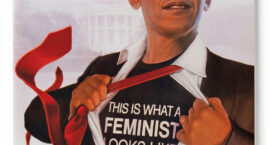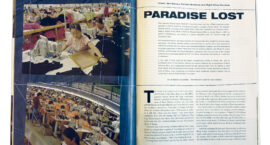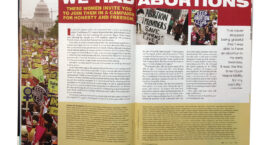Reflecting the magazine’s long collaboration with feminist scholars, Ms. publishes a survey of women’s studies programs nationwide and founds Ms. Classroom, a fully digital feminist teaching curriculum based on current and classic articles from the pages of Ms.
Category: Fifty
“This Is What a Feminist Looks Like”
Capturing the nation’s high expectations, Ms. depicts President Barack Obama as a potential superhero opening his jacket to reveal a feminist T-shirt. Shortly after his inauguration, Obama ends the global gag rule, and the first bill he signs into law is the Lilly Ledbetter Fair Pay Act.
“Good Ole Boys”
Ms. exposes Ward Connerly—whose anti-affirmative-action crusade seriously impacted women and minorities—for his close ties to business interests and the huge salaries he drew from his nonprofits. Later that year, Connerly ends his crusade.
Nancy Pelosi Becomes First Woman Speaker of the House
Ms. is the first national publication to put Pelosi on its cover.
“A Brave Sisterhood”
Ms. is on the ground reporting from Afghanistan during the country’s first democratic elections, in which women candidates, defying extremist violence and threats, win 29 percent of seats in parliament.
“Paradise Lost”
Ms. exposes sweatshops in Saipan, a U.S. territory in the Pacific, where exploited workers are exempt from U.S. labor laws yet manufacture “Made in USA” garments. Not long after, Congress ends the exemption, putting the territory under U.S. labor laws.
“We Had Abortions”
Echoing the pioneering petition from the premier issue of Ms., thousands of women sign on to a “We Had Abortions” campaign as the Supreme Court hears a challenge to President George W. Bush’s so-called partial-birth abortion ban (which the Court upholds in 2007).
“Hanging by a Thread: What’s at Stake if We Lose the Supreme Court”
Ms. shows that it’s not just abortion rights at risk, but the right to birth control as well.
“A Shot Against Cervical Cancer”
Ms. is one of the first magazines to write about the HPV vaccine and how it can help women prevent certain cancers.
March for Women’s Lives Draws More Than 1 Million to Washington, D.C.
The Ms. delegation carries “Stop the War on Women” signs—eight years ahead of mainstream media’s popularization of the expression.







